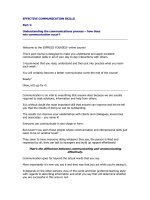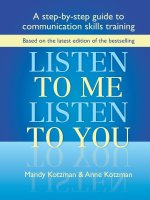Verbal communication skills
Bạn đang xem bản rút gọn của tài liệu. Xem và tải ngay bản đầy đủ của tài liệu tại đây (76.02 KB, 11 trang )
VERBAL COMMUNICATION SKILLS
Effective verbal or spoken communication is dependent on a number of factors and
cannot be fully isolated from other important interpersonal skills such as non-verbal
communication, listening skills and clarification.
Clarity of speech, remaining calm and focused, being polite and following some
basic rules of etiquette will all aid the process of verbal communication.
Opening Communication
In many interpersonal encounters, the first few minutes are extremely
important as first impressions have a significant impact on the success of
further communication.
Everyone has expectations and norms as to how initial meetings should proceed
and people tend to behave according to these expectations. If these expectations
are mismatched, communication will not be effective or run smoothly, and some
form of negotiation will be needed if relations are to continue.
At a first meeting, formalities and appropriate greetings are usually expected: such
formalities could include a handshake, an introduction to yourself, eye contact and
discussion around a neutral subject such as the weather or your journey may be
useful. A friendly disposition and smiling face are much more likely to encourage
communication than a blank face, inattention or disinterested reception.
Reinforcement
The use of encouraging words alongside non-verbal gestures such as head
nods, a warm facial expression and maintaining eye contact, are more likely
to reinforce openness in others.
The use of encouragement and positive reinforcement can:
-Encourage others to participate in discussion (particularly in group work)
-Signify interest in what other people have to say
- Pave the way for development and/or maintenance of a relationship
- Allay fears and give reassurance
- Show warmth and openness.
- Reduce shyness or nervousness in ourselves and others.
Effective Listening
Active listening is an important skill and yet, as communicators, people tend
to spend far more energy considering what they are going to say rather than
listening to what the other person is trying to say.
Although active listening is a skill in itself, covered in depth on our listening pages, it
is also vital for effective verbal communication.
The following points are essential for effective and active listening:
- Arrange a comfortable environment conducive to the purpose of the
communication, for example a warm and light room with minimal background noise.
- Be prepared to listen.
- Keep an open mind and concentrate on the main direction of the speaker's
message.
- Avoid distractions if at all possible.
- Delay judgment until you have heard everything.
- Be objective.
- Do not be trying to think of your next question while the other person is
giving information.
- Do not dwell on one or two points at the expense of others.
- The speaker should not be stereotyped. Try not to let prejudices associated
with, for example, gender, ethnicity, social class, appearance or dress interfere with
what is being said.
Questioning
Effective questioning is an essential skill. Questioning can be used to:
- Obtain information.
- Start a conversation.
- Test understanding.
- Draw someone into a conversation.
- Show interest in a person.
- Seek support or agreement.
Closed Questions
Closed questions tend to seek only a one or two word answer (often simply 'yes' or
'no') and, in doing so, limit the scope of the response. Two examples of closed
questions are "Did you travel by car today?" and "Did you see the football game
yesterday?" These types of question mean control of the communication is
maintained by the questioner yet this is often not the desired outcome when trying
to encourage verbal communication. Nevertheless, closed questions can be useful
for focusing discussion and obtaining clear, concise answers when needed.
Open Questions
Open questions broaden the scope for response since they demand further
discussion and elaboration. For example, "What was the traffic like this morning?"
or "What do you feel you would like to gain from this discussion?" Open questions
will take longer to answer, but they do give the other person far more scope for selfexpression and encourage involvement in the conversation.
Reflecting and Clarifying
Reflecting is the process of feeding-back to another person your
understanding of what has been said. Although reflecting is a specialised
skill used within counselling, it can also be applied to a wide range of
communication contexts and is a useful skill to learn.
Reflecting often involves paraphrasing the message communicated to you by the
speaker in your own words, capturing the essence of the facts and feelings
expressed, and communicating your understanding back to the speaker. It is a
useful skill because:
- You can check that you have understood the message clearly.
- The speaker gets feedback as to how the message is received.
- It shows interest in, and respect for, what the other person has to say.
- You are demonstrating that you are considering the other person’s
viewpoint.
Summarising
A summary is an overview of the main points or issues raised. Summarising can
also serve the same purpose as 'reflecting'. However, summarising allows both
parties to review and agree the communication exchanged between them up to that
point in time. When used effectively, summaries may also serve as a guide to the
next steps forward.
Closing Communication
The way a communication is closed or ended will, at least in part, determine
the way a conversation is remembered.
A range of subtle, or sometimes not so subtle, signals are used to end an
interaction. For example, some people may avoid eye contact, stand up, turn their
body away, or use behaviours such as looking at a watch or closing notepads or
books. All of these non-verbal actions indicate to the other person that the initiator
wishes to end the communication.
Closing an interaction too abruptly may not allow the other person to 'round off'
what he or she is saying so you should ensure there is time for winding-up. The
closure of an interaction is a good time to make any future arrangements. Last, but
not least, this time will no doubt be accompanied by a number of socially
acceptable parting gestures.
--Effective Speaking
Your voice can reveal as much about your personal history as your appearance.
The sound of a voice and the content of speech can provide clues to an individual's
emotional state and a dialect can indicate their geographic roots.
The voice is unique to the person to whom it belongs.
For instance, if self-esteem is low, it may be reflected by hesitancy in the
voice, a shy person may have a quiet voice, but someone who is confident in
themselves will be more likely to have command of their voice and clarity of
speech.
Aspects of Effective Speaking
Effective speaking has nothing to do with the outdated concept of 'elocution'
where everyone was encouraged to speak in the same 'correct' manner.
Rather, effective speaking concerns being able to speak in a public context
with confidence and clarity, whilst at the same time reflecting on your own
personality.
Accents
Regional and ethnic accents are positive; they are part of individual
personality.
Gradually, over the years, through the migration of people and exposure to the
media, accents are being broken down and neutralised. In some ways this is a
shame because accents can add a dimension and distinctiveness to voice and
emphasise individuality.
It is important to get used to the sound of your own voice. Most people are more
relaxed in a private situation, particularly at home, where there are no pressures to
conform to any other social rules and expectations. This is not the case in public
situations when there are all sorts of influences exerted upon the way people
speak.
Try recording your own voice in an informal setting, like at home.
Listen carefully to how you sound in order to become accustomed to your own
voice.
You might also note any aspects of your speech which reduce the overall
effectiveness of your message.
Often people don’t like the sound of their own recorded voice - in the same
way that some people don't like photographs of themselves - they can feel
embarrassed.
Most of us are not used to hearing our own voices and these feelings are totally
normal. Get past the initial, ‘Do I really sound like that?’ stage and develop a better
understanding of your voice.
When relaxed you will feel more confident, therefore by listening to your voice at
home you will have an idea of how you sound to other people. Although you cannot
hear your voice in the same way that others hear you, you can develop an
awareness of its impact on others. Understanding the physical nature of your voice
will give you more control over the way that you use it.
Individuals are all used to using language in an informal way in their everyday lives,
but as soon as a hint of formality is suggested, they can become self-conscious and
seize up. This becomes especially obvious when speaking in front of strangers in a
public setting.
The more you get used to the sound of your voice functioning in a slightly more
formal way, the easier it is when doing it 'for real'. In conversational mode,
individuals tend to speak in short phrases, a few at a time. Reading aloud helps
you to become used to the more fluent sound of your voice.
An exercise to help develop your effective speaking skills:
Find a document to read, something about two pages in length - the first few pages
of a book would work well.
Read your document through silently first, then read it aloud in your normal
speaking voice. Don't worry if you stumble or falter, just pick up and continue to the
end.
Now read it a third time, recording your voice if possible and remember:
Slow down: It is a natural reaction to want to get it over as fast as possible
and this often causes people to stumble over their words. Speeding up also occurs
when you are nervous and usually makes you more difficult to understand.
Keep your head up: Try not to tuck your chin into the book as your voice is
then addressing the floor. Hold your book higher and project your voice.
Pause occasionally: Let the end of a sentence or the end of a paragraph
give you a chance of a small, two or three second rest. Pauses can be useful for
emphasis.
Anyone can improve the sound of their voice and the way they speak in a matter of
days through a few simple exercises, like the one above. To improve you will need
to maintain a certain commitment and practice regularly for a few minutes.
The Effect of Breath on Voice and Speech
The voice is responsive to emotions and sometimes gets 'blocked', which can
prevent or hinder the expression of a range of feelings.
However, it is possible to use physical exercise to help produce a more flexible
voice, in the same way that people who use vocal sounds professionally take
lessons, to ensure that their voices are kept in a versatile condition and ready to
vocalise a range of sounds.
When under stress an individual's breathing pattern will change. When your
muscles are tense you cannot use your lungs to their full capacity, when a
person is frightened or nervous, a common symptom is tension in the neck
and shoulders. This occurs because, when under pressure, over-breathing
tends to occur. Plenty of air is inhaled, but with fast breathing there is not
enough time to exhale and relax.
Good breathing is essential for two reasons:
1. By using full lung capacity the breath will support the voice and the voice
will become richer, fuller and stronger.
This will benefit individuals who have a small voice and who worry that they cannot
be heard when speaking to a group of people. Volume is controlled in the abdomen
not in the throat, so breathing to full strength will allow for greater control of the
voice.
2. Breathing deeply and rhythmically has a calming and therapeutic effect as
it releases tension and promotes relaxation. People who are relaxed are more
balanced, receptive and confident.
It is no coincidence that many religions use rhythmic breathing techniques such as
meditation, yoga and silent contemplation, and vocal release in the form of chants,
mantras or hymn singing as aids to their devotions. By easing physical tension,
mental stress decreases and the mind is effectively freed to follow creative pursuits.
3. Freed to follow creative pursuits.
Breathing Exercise
1. Stand in an easy position with your feet one pace apart, with the
knees ‘unlocked’ and not rigidly pushed back. Keep spine straight, head balanced
and face muscles relaxed.
2. Breathe in to a slow count of three, then out to a slow count of three.
3. Try not to raise your shoulders as you breathe. Breathe in through your nose and
out through your mouth. Consciously think of your breath 'filling down' to the bottom
of your lungs.
4. Put the palm of your hand flat against your abdomen and feel the
movement. Push slightly against your hand as you breathe in and out.
5. Repeat this exercise ten times.
Depending on how you feel after several days of doing this exercise, extend the
count of the out-going breath from three to four, five and six gradually building up to
ten before you need to take another breath. Then count out loud on the out-going
breath from one to ten. Repeat five times.
By building up your control of out-going breath, you will never sound ‘breathy’ or
feel you are 'running out of breath’ when you speak to a group or a meeting.
Vocal Production
The following three core elements of vocal production need to be understood
for anyone wishing to become an effective speaker:
- Volume - to be heard.
- Clarity - to be understood.
- Variety - to add interest.
Volume
This is not a question of treating the voice like the volume control on the TV
remote. Some people have naturally soft voices and physically cannot bellow.
Additionally, if the voice is raised too much, tonal quality is lost. Instead of raising
the voice it should be 'projected out'. Support the voice with lots of breath - the
further you want to project the voice out, the more breath you need.
When talking to a group or meeting, it is important to never aim your talk to the front
row or just to the people nearest you, but to consciously project what you have to
say to those furthest away. By developing a strong voice, as opposed to a loud
voice, you will be seen as someone positive.
Clarity
Some people tend to speak through clenched teeth and with little movement of their
lips. It is this inability to open mouths and failure to make speech sounds with
precision that is the root cause of inaudibility. The sound is locked into the mouth
and not let out. To have good articulation it is important to unclench the jaw, open
the mouth and give full benefit to each sound you make, paying particular attention
to the ends of words. This will also help your audience as a certain amount of lipreading will be possible.
Variety
To make speech effective and interesting, certain techniques can be applied.
However, it is important not to sound false or as if you are giving a performance.
Whilst words convey meaning, how they are said reflects feelings and emotions.
Vocal variety can be achieved by variations in:
- Pace: This is the speed at which you talk. If speech is too fast then the
listeners will not have time to assimilate what is being said. Nevertheless, it is a
good idea to vary the pace - quickening up at times and then slowing down – this
will help to maintain interest.
- Volume: By raising or lowering volume occasionally, you can create
emphasis. If you drop your voice to almost a whisper (as long as it is projected) for
a sentence or two, it will make your audience suddenly alert, be careful not to
overuse this technique.
- Pitch - Inflection - Emphasis: When speaking in public, try to convey the
information with as much vocal energy and enthusiasm as possible. This does not
mean your voice has to swoop and dive all over the place in an uncontrolled
manner. Try to make the talk interesting and remember that when you are nervous
or even excited, vocal chords tense and shorten causing the voice to get higher.
Emphasise certain words and phrases within the talk to convey their importance
and help to add variety.
- Pause: Pauses are powerful. They can be used for effect to highlight the
preceding statement or to gain attention before an important message. Pauses
mean silence for a few seconds. Listeners interpret meaning during pauses so
have the courage to stay silent for up to five seconds – dramatic pauses like this
convey authority and confidence.
Before any important speaking situation, whether it is an appointment, meeting or
talk, it is beneficial to have a voice warm-up.
The voice is an instrument - no musician arrives at a concert hall and launches into
Beethoven without first tuning up. The length of time and frequency of a warm-up is
up to you and will depend on how much speaking you need to do.









